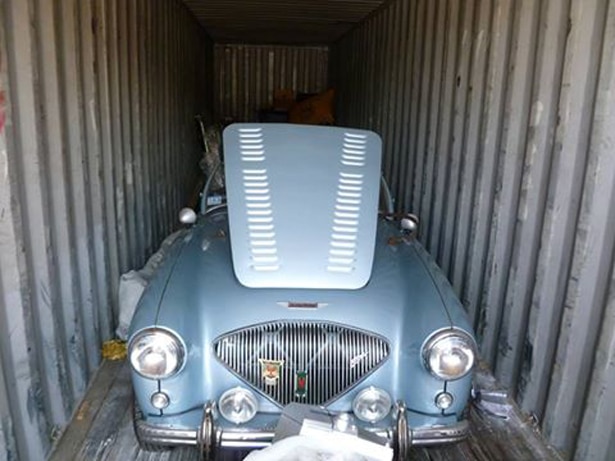 With the internet at our fingertips we now have the ability to scour the earth to find the classic car of our dreams. With a few keystrokes you can now locate potential vehicles to purchase in a matter of minutes. Before this it was a painstaking search through the classifieds and magazines or crawling car shows and auctions to find the right candidate. Before the internet purchasing an exotic classic car from overseas was next to impossible. Today it’s almost as easy to find a classic in Italy as it is in Texas, California or any other US state.
With the internet at our fingertips we now have the ability to scour the earth to find the classic car of our dreams. With a few keystrokes you can now locate potential vehicles to purchase in a matter of minutes. Before this it was a painstaking search through the classifieds and magazines or crawling car shows and auctions to find the right candidate. Before the internet purchasing an exotic classic car from overseas was next to impossible. Today it’s almost as easy to find a classic in Italy as it is in Texas, California or any other US state.
So where should you look if you are interested in finding a foreign classic that is in decent condition? And what is involved with importing it back into the United States? These are two of the most commonly asked questions for those that are looking to purchase a classic car that is out of the ordinary.
Where to Begin Your Search
Many enthusiasts begin their search across the Atlantic in Europe. Italy, Germany, France and the United Kingdom have produced an array of vehicles that now make excellent collector vehicles. Southern Europe is the most common search area because the countries that border the Mediterranean have dryer, warmer climates where rust is not as much of an issue as is seen in the northern European countries.
Some of these southern European countries have also had rougher economical times in the recent past and the exchange rate for the US dollar is favorable. The local population may be more willing to strike a deal in order to make the sale. It is quite possible to find some great deals.
Many Americans are already hip to the fact that there are deals to be made and have been purchasing foreign classics for some time now from the better known countries of Italy and Spain, but some of the lesser known Mediterranean countries like Greece, Croatia and even the island of Cypress still have some great deals to be had if you do your homework.
Other countries like Australia, New Zealand and South Africa also have good climates for cars and also offer a fairly untapped classic car market for American buyers. Australia in particular has some really cool Aussie classic cars and Aussie muscle cars that are sure to turn heads back here on American roads.
Buying a Classic Car Overseas
If you have the time and money then ideally it would be best to have a few vehicles lined up, catch a flight and go see them in person. This way you could be able to “kick the tires” so to speak before you buy it. You would have the chance to get your own appraisal and then strike a deal with the owner.
Not all of us have the time or resources to travel half way around the world to buy a car. In these cases you can either trust the seller or hire a broker to inspect and purchase the car on your behalf. You may also want to hire a shipping agent to help you navigate all the details of getting the vehicle ready to ship out of the country. It is advisable so that you can ensure all the paperwork from the foreign country is in proper order before leaving its homeland.
International Auto Shipping

By far the cheapest way to ship a vehicle overseas is what is known as “roll-on/roll-off” shipping. It is exactly what it sounds like. The car is driven onto a large shipping vessel, strapped down to the deck and then brought across the ocean. While it is the most inexpensive method it also has the highest risk for damage during transit. Not only will it have to endure a few weeks of harsh marine climates, but there are also risks involved during loading and unloading. To qualify for this type of shipping a vehicle must be able to drive itself on and off the ship. If the vehicle in question does not run, then this shipping method is not an option.

A more expensive but certainly more secure option is to place your new classic car into a shipping container. If you are shipping a rare or very expensive vehicle then this really is the only option. The vehicle is strapped securely into its own shipping container which is then locked up for even further safety. After renting the container and paying the freight (usually charged by weight) the container is then loaded onto a cargo ship for transit.
While it is a more costly method of transportation, it comes with multiple advantages. First, it is next to impossible for the vehicle to become damaged during loading and unloading. Second, the vehicle does not have to be in running condition to qualify for shipping. In fact, if there are any extra or disassembled parts with the vehicle they can easily be put into the container as well. Finally, the contents of the container are mostly unknown by the ship’s crew or by anyone responsible for loading or unloading the container.
It may cost considerably more to ship this way, but it will give you peace of mind as your new classic collector is making its way across the ocean.
Importing your Classic Car into the States
Once the vehicle makes it to American customs there really isn’t much you need to do to get it imported. Just make sure it fits into the Federal law as being a “Classic.” US law defines a classic as any vehicle that is at least 25 years old. If it is newer than that you may face hefty import taxes. Again you can hire the services of a shipping agent, like uShip, to help you navigate the paperwork at customs as well as the logistics of shipping.
Should you decide to go through the process yourself there are some important things to know before you ship a car to the United States.
- If the vehicle is 21 years or older your import will not have to comply with EPA requirements.
- If the vehicle is older than 25 years then it does not need to meet DOT Federal Motor Vehicle Safety Standards.
- Vehicles that are 25 years or older will be entered under box 1 on the HS-7 declaration form for customs at the time it is imported in the United States.
- Documentation must be provided that proves the age of the vehicle unless the age of the vehicle is on the car directly from the manufacturer.
- The importer must declare code E on for 3520-1 for the EPA.
- You must provide documentation that proves vehicle ownership.
That is really just about everything. There may be a small amount of import tax (typically 2.5%) that you need to pay, but once you are clear of customs you will be able to title and register the car at your local DMV just like any other vehicle that was purchased in the US. Typically you would provide the DMV with the bill of sale and the title. In many countries there is no such thing as a title, but rather it is just a registration form. US Customs will provide you with a temporary form that you will need to provide to your DMV in order for them to title the vehicle in the United States.
You may also want to discuss your purchase with your insurance carrier to see if they have any special conditions for the vehicle you are importing. Right hand driver vehicles are also exempt from any modification and are legal to drive in America as long as it is considered a “Classic.”
